Dell xps 17 9720 laptop dell xps 9720 review dell xps 17 9720 specs dell xps 17 9700 i7 dell xps 13 dell xps 8950 dell xps 15 9510
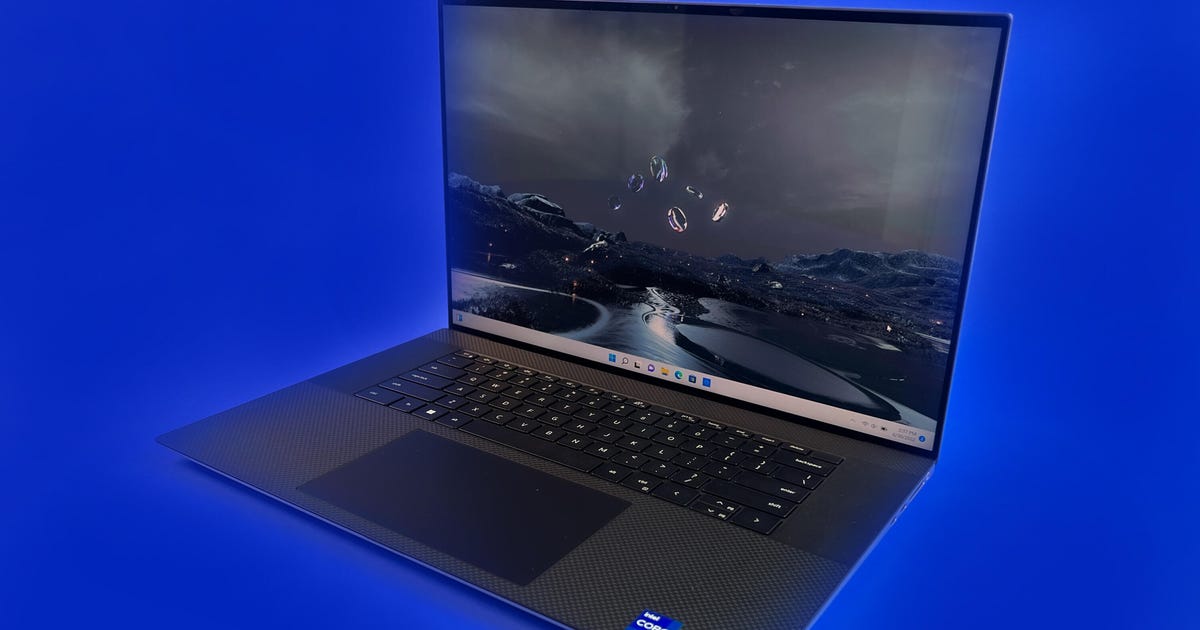
Dell XPS 17 9720 (2022) Review: Creative, With a Side of Gaming
If Apple isn't going to make a 17-inch MacBook Pro, then someone else is going to have to. That's what I always think when I see one of Dell's big-screen XPS 17 laptops.
The oldest XPS 17 review of mine I could find dates back to 2011, although I've been covering this particular product line (or its identically named antecedents) since at least 2007.
Speaking of things that happened a long time ago, 2012 was when Apple discontinued the 17-inch MacBook Pro, and frankly there's still an audience out there for a big-screen 17-inch laptop with that same style and vibe -- a sharp, minimalist design wrapped around hardware that's creative-minded, but also great for students and business types.
One of the machines I use regularly is the 16-inch MacBook Pro, with the M1 Max CPU. It's a powerful (and powerfully expensive) laptop, but 16 inches still isn't 17 inches, so I was excited to spend some time with the latest XPS 17.
The least-expensive XPS 17 right now is $1,750 and includes a 12th-gen Intel Core i5, 16GB RAM, 512GB SSD and a standard 1,920x1,080 display.
This particular configuration adds a lot of noteworthy upgrades to the CPU, graphics and other features. For $2,799 (currently – prices on Dell's website can shift frequently), you get a 12th-gen Intel Core i7, 32GB of RAM, 1TB of SSD storage and the top graphics option in the line right now, an Nvidia GeForce RTX 3060 GPU. The 16:10 touchscreen display has a 4K 3,840x2,400 resolution.
The biggest missing piece is probably a higher-res webcam, which has become ever more important in our Zoom meeting work-from-home era. Instead, the 720-resolution camera has added a discrete IR sensor for better overall camera performance. But note that the 14-inch and 16-inch MacBook Pro laptops, and even the upcoming new MacBook Air, have all upgraded to 1,080-resolution cameras, so it shouldn't be a big ask.

The XPS 17 next to a 16-inch MacBook Pro.
Dan Ackerman/CNETThis hulking silver-gray tank of a laptop is built around the same design as the last few generations of this system. It's a CNC-machined aluminum chassis with carbon fiber on the inside. Despite its heft, I like that the lid can be lifted with one hand, or even by a single finger.
The thin bezel around the large screen minimizes any wasted space, even with the webcam tucked into the top border. Ports are on the thin side for a 17-inch laptop, with just 4 USB-C ports and an SD card reader. For HDMI or USB-A needs, you'll need an adapter or dongle.
Work and play
If you're investing in a big, expensive laptop like this, with CPU and GPU chops, it's probably out of professional interest. This will appeal to the Photoshop, Illustrator and Premiere experts who are not already locked into Apple platforms.
The 4K display is a big help there, as is the taller 16:10 aspect ratio, which lets you fit more work into the screen at once. I threw some Photoshop projects at the system with no problem and appreciated the extra screen real estate.
Dell's keyboard and touchpad are considered excellent among Windows laptops and I've always liked the XPS versions. That said, the touchpad feels more floaty than Apple's best-in-class version.

Ports on the MacBook Pro and XPS 17 compared.
Dan Ackerman/CNETBut the XPS 17 has another trick for you -- it's also a decent stealth gaming laptop. The GPU options top out at the current-gen Nvidia 3060, so it's not going to match a similarly priced gaming laptop, but that GPU is fine for any current or upcoming game, with one important caveat -- you should dial most games down to 1,920x1,200 (FHD) resolution, or maybe 2,560x1,600 (QHD). These are a little different than the standard resolutions (like 1,920x1,080) you might be used to because this is a 16:10 display, rather than a 16:9 one.
Because my time testing this laptop overlapped with Valve's annual Steam Summer Sale, I had plenty of gaming opportunities with it. Among the recent games I played on the XPS 17 were medieval multiplayer game Chivalry 2, Warhammer 40,000: Chaos Gate - Daemonhunters and turn-based RPG King Arthur: Knight's Tale. In general games chugged at higher resolutions but ran great at either FHD or usually QHD.
In fact, the XPS 17 became my main gaming laptop for a while, not because it had the greatest gaming hardware, but because it ran games well enough while offering a great large-format screen.
True big screen laptops are rarer than ever, and 16-inch screens are usually the new 17-inch screens for most. If you're determined to find a 17-inch system that mixes the creativity of a MacBook Pro with mainstream gaming chops, the XPS 17 remains one of the only solutions that will satisfy both sides of that equation.
Geekbench 5 (multicore)
Note:
Longer bars indicate better performanceCinebench R23 (multicore)
Note:
Longer bars indicate better performance3DMark Wild Life Extreme
Note:
Longer bars indicate better performanceSystem Configurations
| Dell XPS 17 9720 | Microsoft Windows 11 Home; 2.3GHz Intel Core i7-12700H; 32GB DDR5 4,800MHz RAM; 6GB Nvidia GeForce RTX 3060 graphics; 1TB SSD | |
|---|---|---|
| MacBook Pro 16 | Apple MacOS Monterey 12.4; Apple M1 Max 10-core chip; 64GB RAM; Apple 32-core GPU; 2TB SSD | |
| Asus Zenbook Pro 16X OLED | Microsoft Windows 11 Home; 2.3GHz Intel Core i7-12700H; 16GB DDR5 RAM; 6GB Nvidia GeForce RTX 3060 graphics; 1TB SSD | |
| HP Spectre x360 16 | Microsoft Windows 11 Home; 3.4GHz Intel Core i7-11390H; 16GB DDR4 3,200MHz RAM; 4GB Nvidia GeForce RTX 3050 graphics; 1TB SSD | |
| Dell Inspiron 16 Plus | Microsoft Windows 11 Home; 2.3GHz Intel Core i7-11800H; 16GB DDR4 3,200MHz RAM; 4GB Nvidia GeForce RTX 3050 graphics; 512GB SSD | |
§

More than nine years after Apple created the first one, Apple's unceremoniously removed its 17-inch laptop from its lineup, announcing just 13- and 15-inch MacBook Pros and the new MacBook Pro with Retina Display at WWDC 2012.
And it's likely that no one will ever miss it.
Apple was the first manufacturer to add a 17-inch laptop to its lineup in 2003 -- the largest screen available from any vendor at the time -- and has had one ever since. But with the new wide-screen, ultrahigh-resolution Retina Display, those extra couple inches might be irrelevant.
After all, mobility is key now, not screen size. It used to be you needed a larger laptop to get performance good enough to replace a desktop, but that's no longer the case. (I mean, look at Apple's tag line above the new models.)
A 15-inch screen is plenty for most purposes when you're traveling, and when you're not, you can connect into an external display. And really, look at how much people can get done on the 9.7-inch iPad screen and 3.5-inch iPhone screen.
What do you think? Is there still a need for a 17-inch MacBook? Do you think it'll make a return when Apple can offer a more affordable 17-inch Retina version?
Source
Wwe elimination chamber 2022 start date wwe elimination chamber 2022 date wwe elimination chamber 2022 time wwe elimination chamber 2022 predictions wwe elimination chamber 2013 wwe elimination chamber 2023 wwe elimination chamber 2011

WWE Elimination Chamber 2022: Start Times, Full Card, How to Watch on Peacock
After the Royal Rumble, the Road to WrestleMania is goes through Saudi Arabia. At Elimination Chamber on Saturday, Bobby Lashley defends his WWE Championship in an Elimination Chamber match against five men, including The Beast Brock Lesnar. Lesnar is angling to make his WrestleMania clash with Roman Reigns a title versus title bout, and to do that he'll need to beat Lashley, AJ Styles, Seth Rollins, Riddle and Austin Theory to win the WWE title.
His WrestleMania opponent, Roman Reigns, isn't taking the night off though. He'll be battling the returning Goldberg, with his Universal Championship is on the line. The other major championship that's up for grabs is Becky Lynch's Raw Women's Championship, as she'll defend the gold against Lita.
Capping off the show, Ronda Rousey will tag with Naomi to take on the team of Charlotte Flair and Sonya Deville. It's Rousey's first match back since returning at the Royal Rumble last month.
Start times
With Elimination Chamber 2022 broadcasting from Riyadh, Saudi Arabia, start times will be different than normal. The show will air 9 a.m. PT/12 p.m. ET on Feb. 19. That's 5 p.m. UK time, which is a treat for people in the region who usually have to wait until midnight to get their grappling fix. This time it's the Australians who have it the hardest: Elimination Chamber airs at 4 a.m. AEDT.
How to watch: Peacock, WWE Network
As you probably know by now, Peacock is the new home of WWE's pay-per-views. The WWE Network has in essence migrated to NBC's Peacock streaming service, and that's where you'll go to watch Elimination Chamber 2022. Peacock has three tiers: Free, Premium and Premium Plus. To watch WWE content, you'll need a Premium subscription. The good news is that'll set you back $5 a month, less than the $10 for WWE Network.
If you're outside of the US, you'll watch Elimination Chamber 2022 on the WWE Network as usual.
Match card
- WWE Championship Elimination Chamber: Bobby Lashley (c) vs. Brock Lesnar vs. Seth Rollins vs. Austin Theory vs. Riddle vs. AJ Styles.
- WWE Universal Championship: Roman Reigns (c) vs. Goldberg.
- Elimination Chamber for WWE Raw Women's Championship opportunity at WrestleMania: Liv Morgan vs. Bianca Belair vs. Doudrop vs. Nikki A.S.H. vs. Rhea Ripley vs. Alexa Bliss.
- Ronda Rousey and Naomi vs. Charlotte Flair and Sonya Deville
- WWE Raw Women's Championship: Becky Lynch (c) vs. Lita.
- WWE SmackDown Tag Team Championship: The Usos (c) vs. The Viking Raiders.
- Drew McIntyre vs. Madcap Moss.
- The Miz vs. Rey Mysterio.
Source
Lenovo yoga 9i 14 inch reviews lenovo yoga 9i gen 7 release date lenovo yoga 9i 14 inch lenovo yoga 9i 14 review lenovo yoga 9i 14 dimensions lenovo yoga 9i gen 7 14 intel lenovo yoga 9i gen 7 uae lenovo yoga 9i gen 7 lenovo yoga 9i gen 7 test lenovo yoga 9i gen 6 lenovo yoga 9i gen 7 oatmeal lenovo yoga 9i 15
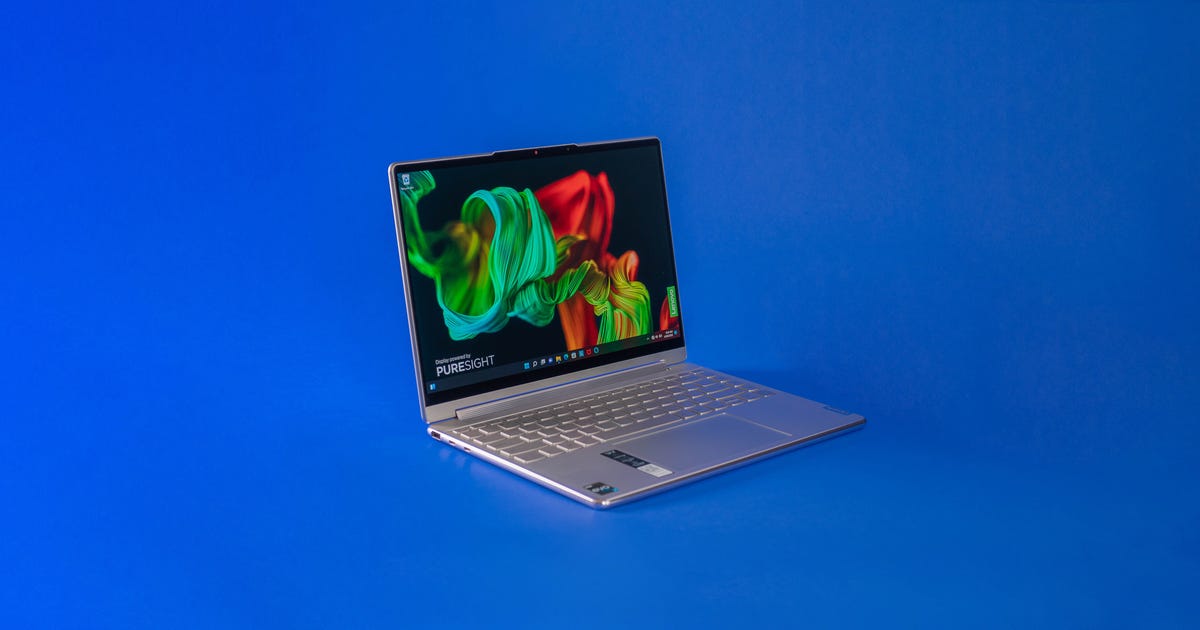
Lenovo Yoga 9i (Gen 7, 14-inch) Review: Pretty. Impressive.
Lenovo's Yoga line of two-in-ones is now 10 years old. It's not surprising the line has lasted this long: It was the best two-in-one design to come out with the launch of Windows 8. It's a laptop, a tablet, a digital whiteboard, a small all-in-one PC, an immersive mobile gaming display and a kitchen companion. All these years later, the Yoga's flexibility remains outstanding and Lenovo's flagship 14-inch Yoga 9i Gen 7 lets you take full advantage of that fact.
The design, display options and processors are all fresh for the Yoga 9i. Lenovo rounded off all the edges and corners on its aluminum body to make it more comfortable to carry and rest your wrists on while typing. Though I'm on the fence about the look of it (pretty, but there's something about it that seems dated), there's no denying how nice it is to not have the laptop edges digging into my wrists. And as with past Yoga 9-series models, everything looks and feels premium, right down to the included active pen and laptop sleeve.
The Yoga 9i has a premium price, too, assuming you can find one to buy. Lenovo has a base model Yoga 9i on its site for $1,080 (and occasionally it's even in stock) with an odd combo of a 12th-gen Core i7 paired with just 8GB of memory soldered on, a 256GB PCIe Gen 4 SSD and a 1,920x1,200-resolution display. The configuration I tested is decidedly higher-end with twice the memory and storage of that model plus a 2,880x1,800-resolution OLED display. It's a Best Buy exclusive for $1,730; as far as I can tell, it isn't listed on its website.
UK and Australia buyers fare much better with multiple configurations to choose from including the one reviewed here for £1,350 and AU$2,849. Availability has been and will continue to be an issue for the foreseeable future for all PC makers, not just Lenovo, which makes recommending anything difficult.
Lenovo Yoga 9i (14-inch, Gen 7)
| Price as reviewed | $1,730 (£1,350, AU$2,849) |
|---|---|
| Display size/resolution | 14-inch 2,880x1,800 OLED touch display |
| CPU | 2.1GHz Intel Core i7-1260P |
| Memory | 16GB LPDDR5 5,200MHz (soldered) |
| Graphics | 128MB Intel Iris Xe Graphics |
| Storage | 512GB PCIe NVMe Gen 4 SSD |
| Connections | USB-A 3.2 Gen 2, Thunderbolt 4 (x2), USB-C 3.2 Gen 2, 3.5mm audio jack, microSD card slot |
| Networking | 802.11ax (Wi-Fi 6E), Bluetooth 5.2 |
| Operating system | Windows 11 Home 21H2 |

The 2.8K OLED display is easy on the eyes.
Joshua Goldman/CNETLots to look at
Lenovo offers the Yoga 9i with three 16:10 touchscreen options: a full-HD LCD with 100% sRGB color gamut, and a 2.8K OLED or 4K OLED with 100% P3 color gamut. The 2.8K OLED is a good balance between performance and pure eye candy, covering 100% sRGB, 99% P3, 98% Adobe RGB and 95% NTSC color gamuts. Though Lenovo rates its brightness at 400 nits, I measured it at 354 nits. However, switched into HDR mode, the peak brightness is 617 nits. It can also be switched from 60Hz to 90Hz for smoother-looking fast movement.
Mind you, none of this improves battery life, which came in at 10 hours, 31 minutes on our streaming video test with HDR off, the refresh rate at 60Hz and brightness and audio through earbuds set at 50%. That's not bad, and it charges fast via a USB-C port. If better battery life is necessary, though, opt for the full-HD LCD.
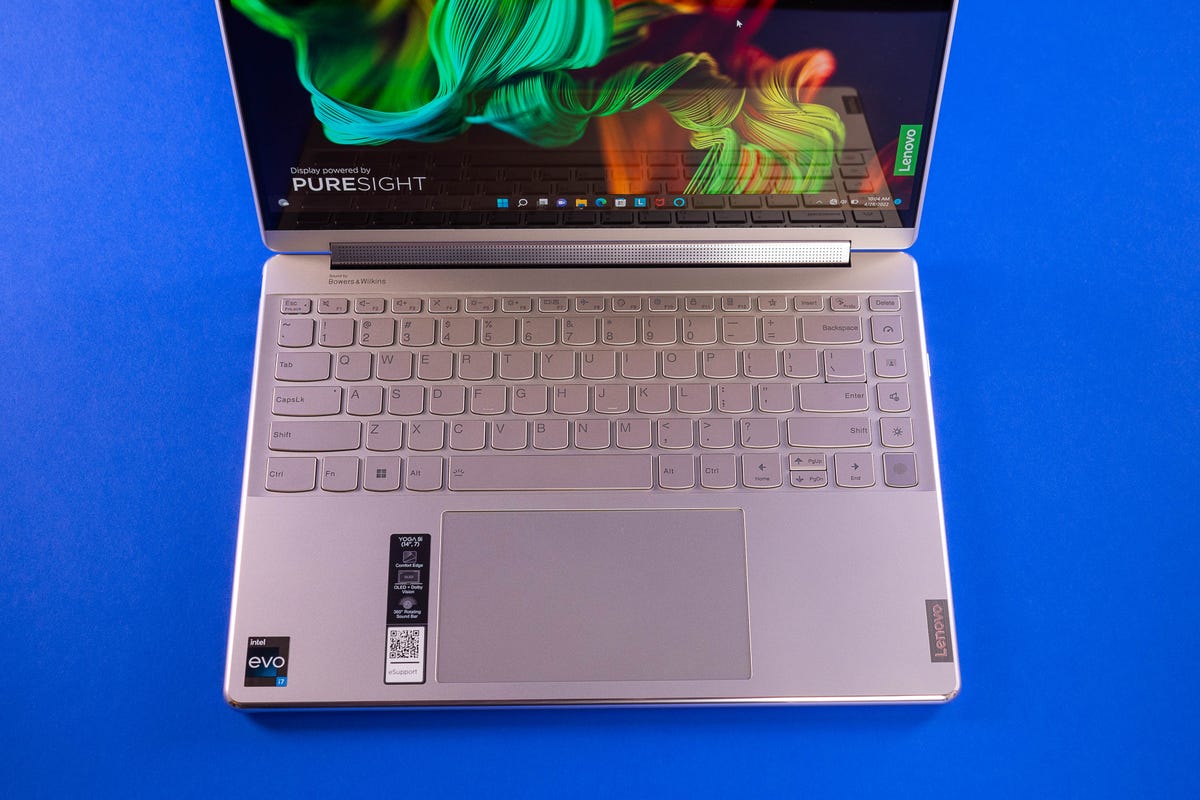
The keyboard and larger touchpad are a pleasure to use.
Joshua Goldman/CNETThe hybrid life
With more people working remotely now, PC makers have been forced to make some long-overdue changes to laptops... namely improvements to webcams, mics and audio. The Yoga 9i Gen 7 has a good 1080p webcam paired with an IR camera and dual far-field microphones. The IR camera is for signing in with facial recognition. But the Yoga 9i also has presence detection, a feature first found on ThinkPad business laptops.
If you walk away from the laptop, it will automatically lock itself down. When you return, the Yoga 9i senses your presence and starts looking for your face to unlock it instantly. The feature can even be used to pause video playing on the display when you leave and resume upon return when using certain players like VLC. There's also a physical webcam shutter for privacy when you want it.
Lenovo also added a row of shortcut keys down the right side of the keyboard. These one-click Function keys give you direct access to four features designed to make it easier to use the 9i for hybrid work or learning. There's a key that controls your fans for quiet or increased performance, one that instantly adds a background blur when you're using a video conference app and another for choosing audio profiles for music, gaming or movies.
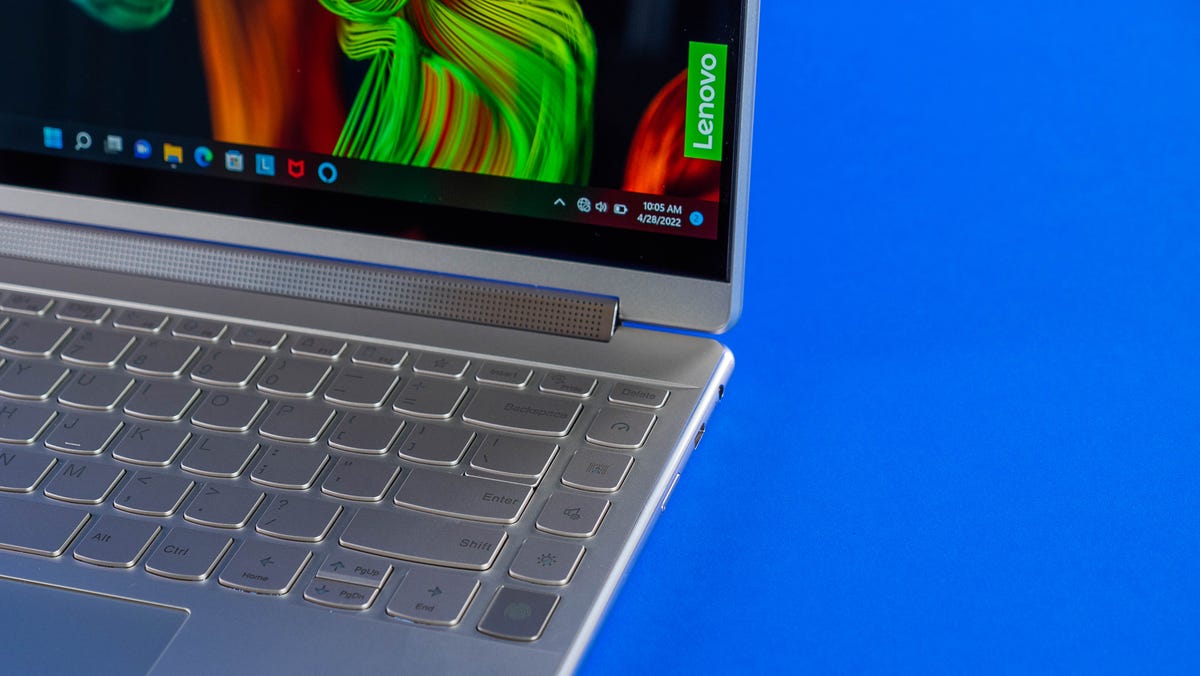
There's a fingerprint reader at the bottom of the one-click Function keys.
Joshua Goldman/CNETWith Dolby Atmos support and the Yoga 9i's 360-degree soundbar hinge with quad Bowers & Wilkins speakers (two woofers and two tweeters), all of those modes have some of the best sound quality I've heard from a laptop, especially one so thin. However, the speakers do vibrate the chassis and you can feel it in the palm rests. It didn't bother me much, because I typically listen to music with headphones while working and my hands aren't usually on the keyboard when watching videos. But I could see how someone might find the vibration irritating while typing.
The fourth key is for quickly flipping between light and dark modes in Windows 11. This might seem kind of silly, but if you get the Yoga 9i with one of its OLED display options, dark mode is a good way to conserve battery life. Below that is a fingerprint reader for quick sign-ins if you don't use facial recognition.
To my surprise, I ended up using all of the one-click Function keys way more than I thought I would. The background blur key in particular. Lenovo also packs some similarly handy features into its Vantage software. It's where the presence-detection settings mentioned earlier are found as well as options for cooling, power, audio, display and camera and wireless network performance. However, as helpful as it is, it's also the company's avenue for pitching you on various partner services.

Things like SurfEasy VPN, McAfee LiveSafe, DashLane password manager and Lenovo's own Smart Performance service for $30 a year, which scans your PC and fixes any issues it finds. This is also where you'll get offers for extended warranties for the laptop and battery. It's aggravating but I suppose it's better than having all of these preinstalled. Only the McAfee software is preinstalled and it should probably be the first thing uninstalled for its annoying pop-ups alone.
The Lenovo Yoga 9i Gen 7 continues the company's streak of fantastic premium two-in-ones. The 12th-gen Intel processor delivers a big performance jump in multicore tasks compared to its predecessor, and the features and design are worth the higher price.
Now if only it was available to buy...
Geekbench 5 (multicore)
Samsung Galaxy Book 2 Pro 360 15
Lenovo Yoga 9i (14-inch, Gen 7)
Dell Inspiron 7415 2-in-1
Lenovo Yoga 9i (14-inch, Gen 6)
Note:
Longer bars indicate better performanceCinebench R23 CPU (multicore)
Samsung Galaxy Book 2 Pro 360 15
Dell Inspiron 7415 2-in-1
Lenovo Yoga 9i (14-inch, Gen 7)
Lenovo Yoga 9i (14-inch, Gen 6)
Note:
Longer bars indicate better performancePCMark 10 Pro Edition
Lenovo Yoga 9i (14-inch, Gen 7)
Samsung Galaxy Book 2 Pro 360 15
Dell Inspiron 7415 2-in-1
Lenovo Yoga 9i (14-inch, Gen 6)
Note:
Longer bars indicate better performance3DMark Wild Life Extreme
Samsung Galaxy Book 2 Pro 360 15
Lenovo Yoga 9i (14-inch, Gen 7)
Samsung Galaxy Book Pro 360 15
Note:
Longer bars indicate better performanceStreaming video playback battery drain test (minutes)
Lenovo Yoga 9i (14-inch, Gen 6)
Samsung Galaxy Book 2 Pro 360 15
Dell Inspiron 7415 2-in-1
Lenovo Yoga 9i (14-inch, Gen 7)
Note:
Longer bars indicate better performanceSystem Configurations
| Razer Book 13 (late 2020) | Microsoft Windows 10 Home (64-bit); 2.8GHz Intel Core i7-1165G7; 16GB DDR4 SDRAM 4,267MHz; 128MB Intel Iris Xe graphics; 256GB SSD |
|---|---|
| Asus ZenBook Duo 14 UX482 | Microsoft Windows 10 Home (64-bit); 2.8GHz Intel Core i7-1165G7; 8GB DDR4 SDRAM 4,267MHz; 128MB Intel Iris Xe graphics; 512GB SSD |
| Lenovo Yoga 9i (14-inch) | Windows 11 Home 21H2; 3.0GHz Intel Core i7-1185G7; 16GB DDR4 SDRAM 4,267MHz; 128MB Intel Iris Xe graphics; 512GB SSD |
| Acer AP714-51T Porsche Design Acer Book RS | Microsoft Windows 10 Home (64-bit); 2.4GHz Intel Core i5-1135G7; 8GB DDR4 SDRAM 4,267MHz; 128MB Intel Iris Xe graphics; 512GB SSD |
| Asus ZenBook 13 UX325EA-AH77 | Microsoft Windows 10 Pro (64-bit); 2.8GHz Intel Core i7-1165G7; 16GB DDR4 SDRAM 4,267MHz; 128MB Intel Iris Xe graphics; 1TB SSD |
| HP Envy x360 13 (2020) | Microsoft Windows 10 Home (64-bit); 2.3GHz; AMD Ryzen 5 4500U; 8GB DDR4 SDRAM 3,200MHz; 512MB Radeon graphics; 256GB SSD |
Source
What to know about omicron and its subvariants escape what to know about omicron and its subvariants of omicron what to know about omicron and long covid what to know about omicron and sore what to know about divorce research what to know about psoriatic arthritis driving in ireland what to know what to know about divorce what to watch what to say to someone who lost a loved one what to make with ground beef

What to Know About Omicron and Its Subvariants (Including BA.5)
For the most up-to-date news and information about the coronavirus pandemic, visit the
WHOand
CDCwebsites.
What's happening
The omicron variant of COVID-19 keeps changing, creating newer, more contagious variants. BA.5 seems to be the most contagious version to date and is causing most of the current COVID-19 cases in the US.
Why it matters
BA.5 is causing more reinfection in people who already had COVID-19, including earlier versions of omicron. It's also evading immunity from the vaccines.
What it means for you
The vaccines are still effective at preventing severe disease and death. To stay protected, get the booster shots you're eligible for and wear a mask in public.
COVID-19 cases in the US appear to be on a downward trend, according to a report from the US Centers for Disease Control and Prevention and the New York Times COVID-19 tracker. But most counties in the US still have a "medium" or "high" level of COVID-19, which continues to guide COVID-19 recommendations after the CDC recently updated its guidance. The updated guidance removes the quarantine recommendation for people who aren't vaccinated and other adjustments as the CDC tries to move the US into a new phase of COVID-19.
The cause of most COVID-19 infections this summer is BA.5, the newest subvariant of the omicron variant. Scientists believe BA.5 is the most contagious version of COVID-19 thus far, and it's responsible for about 89% of current cases, according to the latest data from the CDC.
At a White House COVID-19 Response Team briefing July 12, Dr. Anthony Fauci, the president's chief medical adviser, explained how the virus that causes COVID keeps mutating and that the virus has "essentially bumped one variant off the table after the other," which has led to a long parade of increasingly contagious subvariants of omicron. BA.5 is the newest, and a highly problematic, mutation.
Though BA.5 "substantially" evades antibodies from prior infections and vaccines, health officials say being up-to-date with a booster (or two boosters if you're 50 or older) still protects against severe disease and death. Research so far shows that BA.5 doesn't overcome those protections against severe disease, though more research is needed to understand its clinical severity compared with earlier subvariants of omicron.
In an effort to target the most relevant strain of virus causing COVID-19, vaccines based on the BA.5 subvariant (along with BA.4) will be the first choice for COVID-19 booster shots this fall, to be rolled out as early as September. Response Team Coordinator Dr. Ashish Jha encouraged everyone to get a booster if they're eligible and haven't opted for one yet, because it won't affect people's ability to get vaccinated come fall or winter when they become eligible. Second boosters of the existing vaccines will likely only be recommended until then for adults 50 and up and younger adults and teens who are immunocompromised.
COVID-19 treatments, including Paxlovid, are predicted to be effective still, and the US Test to Treat clinics are still up and running to connect people most at risk with prescriptions for treatments if they need them.
Here's what we know about BA.5.
Read more: Best COVID Face Masks For Kids
Do the at-home tests detect BA.5?
Right now there's no reason to suggest that the at-home rapid COVID-19 tests (a few boxes of which are free when you order through the government's website) are less effective in regard to BA.5 compared with earlier versions of omicron. Generally speaking, the FDA says early data suggests the antigen tests detect omicron but may have reduced sensitivity. BA.5 is a version of omicron, and tests are expected to work the same.
But as of last week, the FDA strengthened its stance on the importance of testing more than once. To be positive you don't have COVID-19, the FDA says you should take a third test if the first two were negative, but you're concerned you were exposed to COVID-19. Taking another home test 48 hours after your second negative test will help catch an infection, as a study found that repeat testing over a longer time frame is more accurate, per the FDA.
"Positive results remain highly accurate for these tests, though there still can be false negatives," Shaili Gandhi, vice president of pharmacy at SingleCare, said in an email. This is because it takes a higher amount of virus to test positive on a rapid test than the highly sensitive PCR or lab-based tests. People who are fully vaccinated and boosted, for example, may have a very low viral load (smaller amount of virus) and that may mean they test negative even if they do have COVID-19.
Typically, rapid home tests work by detecting the part of the COVID-19 virus protein that doesn't change much between variants, called the nucleocapsid, Slate reports. "Because of that, the tests are able to detect the different variants," Nate Hafer, an assistant professor of molecular medicine at UMass Chan Medical School, told the publication.
Long story short: take the test.
Read more: New Booster for COVID: Here's the Fall 2022 Vaccine Plan
How severe is BA.5? Do COVID-19 treatments still work?
BA.5 is a subvariant of omicron, which means it's different from the "original" omicron, but not different enough to constitute its own variant status. (Delta is a different variant from omicron and beta, for example.) BA.5 is understood to be the most contagious version of the virus yet, however, and it's evading immunity. This means more people will get reinfected with COVID-19, which can put them at risk of complications and long COVID symptoms, even if the infection itself was mild.
Walensky said last week that we don't definitively know yet about the clinical severity of BA.5 compared to earlier subvariants of omicron. As the pandemic drags on and most of the population has some immunity from vaccines and prior infections, it can become harder to compare variant and subvariant severity in the real world.
In an analysis of a preliminary (not yet peer-reviewed) report from the Kirby Institute in Australia, however, Dr. Eric Topol, a professor of molecular medicine at Scripps Research, wrote that BA.5's ability to infect cells might be more similar to the delta variant than other versions of omicron. He also writes that changes in BA.5 might explain reports of people taking longer to test negative compared to illnesses with earlier omicron subvariants.
As with other versions of omicron that whittled down our immunity, the vaccines and boosters available are still expected to provide protection against severe disease and death. Boosters -- including a second booster -- have been particularly important for protecting older adults and other people more vulnerable to severe disease in the age of omicron, and have substantially cut the risk of death from COVID-19.
Paxlovid, an effective antiviral medication, is still expected to be effective at treating COVID-19 in people at higher risk of severe disease, Fauci said. The monoclonal antibody therapy available, bebtelovimab from Eli Lilly, is also predicted to be effective against BA.5, as is Evusheld. Evusheld
If you test positive for COVID-19 and are at higher risk of severe disease (you're an older adult or you have a health condition), reach out to your doctor or find a Test to Treat clinic near you.
What are the symptoms?
Right now, there aren't any reports that show BA.5 is giving people different symptoms compared to earlier versions of omicron.
For many people who become sick with COVID-19 these days (particularly those who are fully vaccinated and boosted), symptoms resemble cold symptoms such as sore throat, runny nose and fatigue. Back pain is a peculiar new symptom of COVID-19 that some people with omicron have reported, and the once very common loss of taste or smell appears to be much less common with omicron variants than with older strains.
If you have symptoms and are wondering whether it's COVID-19, taking a test and staying home while you're sick will help protect people more vulnerable to severe COVID-19 disease.
Read more: Is It Allergies or COVID? How to Tell the Difference

Understanding omicron, variants and subvariants
Variants are made up of multiple lineages and sublineages. Each variant has a "parent" lineage, according to the CDC, followed by other lineages, which you can think of like a family tree. As the virus spreads between people, mutations occur, but not all of them change the characteristics of the virus in meaningful ways.
The omicron variant and its sublineages made the virus much more contagious and capable of infecting more people, but it's led to less severe disease, on average, than the delta variant.
One of the most important things we can do to stop the virus from mutating is keeping community levels of COVID-19 low so the virus has less chance to mutate, Fauci said.
Genomic surveillance can detect variants and sublineages. Scientists in South Africa were able to quickly identify omicron as a new variant because of the way it presents through PCR tests. The original omicron causes a dropped signal or marker on the test that sets it apart from delta, which was the dominant variant prior to omicron. BA.2, however, didn't have the same signal, called an S gene target failure. This made it more "stealthy" and gave it its name. Genomic sequencing will detect all omicron subvariants and coronavirus variants in general.
However, detecting new variants or subvariants may be becoming more difficult as the number of sequences shared across the world have "dropped precipitously," Dr. Maria Van Kerkhove, an infectious disease specialist with the World Health Organization, said in June. While the impact was still enormous, having real-world data available quickly after scientists detected omicron was a benefit during the worldwide surge last winter.
The information contained in this article is for educational and informational purposes only and is not intended as health or medical advice. Always consult a physician or other qualified health provider regarding any questions you may have about a medical condition or health objectives.
Source
Lorex 2k pan tilt indoor security camera review eyes on the street lorex 2k pan tilt indoor security camera review eyes on the street lorex 2k pan tilt wifi w462aqc e lorex 2k pan tilt outdoor wi fi security camera lorex 2k pan tilt wifi lorex 2k pan tilt camera lorex 2k camera set up lorex 2k network camera without a recorder

Lorex 2K Pan-Tilt Indoor Security Camera review: Eyes on the Wyze
In the new era of super-cheap security cameras that work indoors and out, specialized indoor cams that cost more than $30 are an increasingly hard sell. But one feature that can set an indoor camera apart from bland competitors is the ability to move -- to pan or tilt to capture the best possible image of what's going on in your house.
I'm a fan of panning and tilting cameras because they're so flexible: you can use them as pet cams, nanny cams, covering multiple interior rooms by positioning them at a corner or covering an indoor and outdoor area by placing them on a windowsill. In short, they're fantastic gadgets.
And I was excited to try out Lorex's $70 2K Pan-Tilt Indoor Security Camera because it brought a couple of extra goodies to that equation, including a privacy mode where the camera tucks into its casing, physically blocking the feed. But a few performance problems plague this panning-tilting camera, stopping it from besting the rest of the category.

The good
Lorex's pan-tilt camera is quick to set up and easy to use. The app is straightforward and packs an impressive amount of information and control into an accessible user interface.
Much like other similar cameras, you can opt to manually control the panning and tilting, guiding the Lorex's eye around the room as you view the live feed. From the app, you can also adjust resolution, use two-way talk and tweak a variety of other features, like night vision and HDR.
When I tested the Lorex, everything worked as advertised: the feed is clear with little lag, the 2-way talk is quick and sounds decent, and manually looking around the room with the camera's panning and tilting functions is intuitive and genuinely useful.
But most of this isn't particularly revolutionary. In fact, you can get the same features from most of Lorex's competitors -- sometimes for a lower price.
Lorex does beat competitors in a few key categories, though. The biggest one is its included local storage. While the Wyze Cam Pan v2 includes a slot for a microSD card, the Lorex includes a 64GB card in it upon purchase, which means you get a ton of storage right there on the camera. Sure, you can get one of these cards for under 10 bucks, but I like the convenience and the value added to the camera.
The other feature I really like from Lorex is the privacy mode. Where some cameras slide a cover over the camera lens to accomplish this, the Lorex simply tilts its lens into the body of the device, obscuring its view. Many more affordable cameras don't include a privacy mode at all, and I appreciated the ingenuity displayed in Lorex's.
The bad
While the Lorex starts off strong, it's not perfect.
My favorite feature with cameras like this is automatic panning and tilting to follow people (or animals) entering or exiting the frame. This was the first problem I ran into with the Lorex. You can activate this feature, which is currently in beta, but a person walking through the frame at a moderate distance (say, 8 feet from the cam) and at a normal walking pace is apparently too fast for the camera to follow.

The Lorex Pan-Tilt can cover a much larger space than most indoor cameras thanks to its movement functions.
Hobie Crase/CNETI tested the feature dozens of times, and every time I walked into the frame, the camera would turn toward where I'd entered -- the opposite direction I was walking -- and ignore my leaving the frame moments later. Turning up the camera's sensitivity helped the problem a little bit, but it still didn't follow my motion the majority of the time, unless I was walking much more slowly than was natural.
This feature may be helpful at responding to motion right at the edge of a frame, but it certainly won't follow the path of a subject around a room.
What's more, you can't set the camera to automatically pan back and forth (or patrol) across a room -- which defeats some of the value of having a panning camera in the first place.
These two shortcomings seriously limit the Lorex's ability to compete with similar devices. The Wyze Cam Pan v2, for example, can both follow a subject smoothly and efficiently around a room and also scan a room periodically.
The last issue with the Lorex Pan-Tilt is how motion zones work. Because the camera can move, drawn-on motion zones don't exactly work as they do with static cameras. While I haven't seen any cameras do a great job of creating motion zones across a whole panorama, it feels like a wasted feature, given how the zones you want your camera to attend likely change depending where the camera is pointed.
Considering everything
The Lorex is a solid value: you get a smart cam with a crisp feed and mobility that beats out most competitors, plus an included microSD card for local storage. That puts it easily within striking range of one of the best affordable pan-tilt security cameras on the market: the Wyze Cam Pan v2.
What stops it from toppling our favorite panning and tilting camera is the performance. Because the camera can't follow motion consistently across a room -- and it can't even scan a room periodically -- much of the potential of the panning/tilting functions are wasted.
If you're more interested in using the camera to manually check on things at home -- and to record them locally for later review -- then the Lorex Pan-Tilt will be a solid pick. If you're looking for a smart cam to automatically monitor motion around the house, though, you may want to look elsewhere.
Source
Top smart home gadgets smart home gadgets amazon best new home gadgets smart home gadgets website smart home gadgets amazon smart home gadgets website crazy smart home gadgets matter smart home smart home products smart home systems which smart watches make phone calls
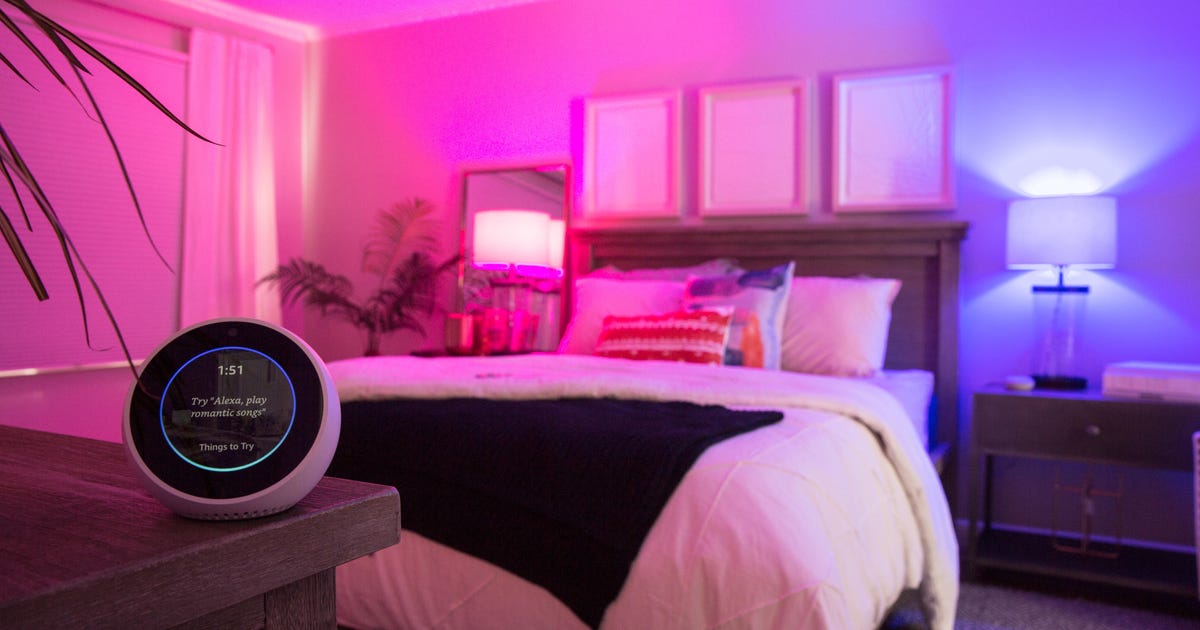
Which smart home gadget should you buy first?
Smart home tech is nothing new -- hobbyists have been geeking out over home automation for decades now -- but in recent years, it's marched closer to the mainstream than ever before. In recent years, high-profile connected home gadgets like the Amazon Echo, the Nest Learning Thermostat and the Ring Video Doorbell have all become breakout hits by offering attractive designs and tangible benefits, many of them at prices that aren't unreasonably high.
The result? A mainstream smart home market with an awful lot of momentum. In 2018, a GfK study found that over half of US households now include at least one smart home gadget. Over a third of them include two or more.
Of course, that leaves about half of us who still haven't bought in. Many might be put off at the thought of connecting everything under their roof and sharing data picked up by sensors, security cameras and microphones with Silicon Valley -- but with a wide variety of smart devices available in your local hardware store, others simply might not know where to start. To that end, here's a look at how to answer a not-so-simple question: Which smart home product should you buy first?
Disclosure: CNET may get a share of revenue from purchases made through the links on this page.
Plan for a purpose-driven smart home
Ask yourself: What do you want from your smart home? As a guy who listens to pitches for the latest smart home technology day in and day out, I can assure you that you've got lots of options. Do you want to keep an eye on things with a do-it-yourself security system and camera feeds you can check from your phone? Do you want simple conveniences like voice controls for your lights and thermostats? Do you want artificial intelligence and cloud-connected appliances to help freshen things up in the kitchen?
To figure out what you want, think about the things you do at home on a daily basis and look for improvements that you'd find meaningful. Do you tend to wander from room to room before bed turning off lights that the kids left on? Smart bulbs that you can turn off with a single voice command or tap on your phone might make sense. Do you shop online a lot, and worry about thieves stealing packages off your porch while you're at work? A video doorbell with a feed you can view remotely might be a good fit.
For my money, I think smart lighting is a sensible starting point for almost everyone. After all, we use the lights in our home more than just about anything else -- adding in things like motion-activated lights for the exterior of your home or automatic wake-up fades that sync with your morning alarms make a lot of sense, because you'll enjoy them day in and day out. For more on why it's a great time to try smart lights, click here.
Value versatility
If nothing specific jumps out at you and you just have a general curiosity about what the smart home might have to offer, then look for flexible, multifunctional devices that you can use in lots of different ways. A small smart speaker like the Amazon Echo Dot or Google Home Mini is a great way to see what artificially intelligent in-home helpers like Alexa and Google Assistant are capable of, and neither one will cost you more than $50. The WeMo Mini smart switch from Belkin is even cheaper, and it'll let you automate anything you plug into it -- lamps, desk fans, crock pots, space heaters, you name it.
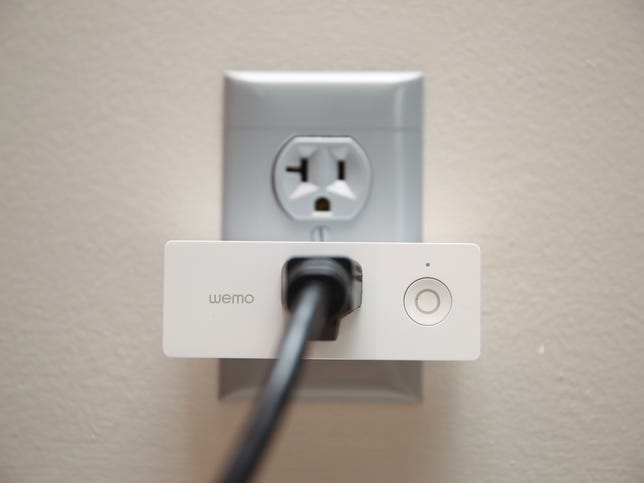
The WeMo Mini Smart Switch from Belkin is a versatile little gadget that automates anything you plug into it. Available for just $30, it's a good, low-risk step into the smart home.
Tyler Lizenby/CNETAs always, when in doubt, start small. Once you find a product that you like, you can start to build around it by adding in other, compatible gadgets capable of making it even smarter and contributing some unique appeal of their own. Our smart home compatibility tracker can be a really helpful tool to that end.
Ponder your platform options
If you're buying a new computer, you'll need to decide which operating system you'd like to use -- Mac, Windows, Chromebook, etc. Smart home tech is similar in that a majority of the most popular gadgets are designed to work within a wider ecosystem of devices -- the most common being voice control platforms like Amazon Alexa, Google Assistant and the Siri controls that come with Apple HomeKit. Control hubs from names like Wink and Samsung SmartThings offer dedicated platforms capable of helping different devices get along, too. You could also keep things working together by sticking to gadgets that work with IFTTT, a free, online automation platform.
Understanding the strengths and weaknesses of each of those options can go a long way toward helping you build out a smart home setup that makes sense for you, particularly if you're planning on using multiple types of gadgets. The smart home is just better when things work together.
That said, most devices offer their own dedicated apps and controls, and can be used independent of any broader platforms right out of the box. That means that you don't necessarily need to make any commitments right away. On top of that, a growing number of products support multiple platforms. Starting with smart devices like those can help you keep your options open if you're undecided for now.
I'll add that each platform has its own security certification process designed to keep insecure, vulnerable hardware out of the mix -- that means that a product that works with multiple platforms has essentially gotten multiple passing grades from names like Apple, Amazon, Google and Samsung, all of which have a lot at stake when it comes to keeping their respective platforms secure.
Here are a few quick suggestions that fit the bill:
Available with two bulbs or four, Philips Hue's white-light smart bulb starter kit is relatively affordable, and it's easy to use and build upon -- plus, it works with just about everything you could imagine.
Ry Crist/CNETSmart lights

Along with automating whatever you plug into the side of it, the iDevices Switch will monitor your energy use and double as a multicolor nightlight, and it works with Apple HomeKit, Amazon Alexa and the Google Assistant.
Tyler Lizenby/CNETSmart plugs
Available for $100 and packed with helpful features, the Honeywell Lyric T5 is one of our favorite smart thermostat value picks, and it works with a wide variety of platforms.
Chris Monroe/CNETSmart thermostats

The Kwikset Obsidian is a keyless smart lock that supports a number of platforms, including Amazon Key for in-home package delivery.
Tyler Lizenby/CNETSmart locks
I'd also add that if you have any interest in voice controls, then starting off with either an Amazon Echo Dot or a Google Home Mini is one of the smart home's biggest no-brainers. Even if you ignore the smart home integrations that let Alexa or the Google Assistant control things like lights and thermostats, each device is arguably worth the $50 asking price for the voice-activated music, podcasts, news headlines and cooking timers alone.
Do your homework
The best way to pick the right gadgets for your home is to understand what all of the different options have to offer and narrow things down accordingly. With such a huge variety of alternatives battling it out in a complex arena of competing platforms and standards, doing so can get confusing in a hurry.
But hey, that's where we come in! Our product reviews, best-of lists, buying guides, how-to content, explainer posts and featured dispatches from the CNET Smart Home are all aimed at helping you understand what a more connected living space has to offer (and where it falls short). If you're looking for ideas as to how you might put a smarter home to work, we'll help you brainstorm. If you're stuck trying decide between two seemingly identical gadgets, we can help with that, too. If you want to dive deeper into privacy and security concerns before buying in, we've got you covered.
Bottom line: There's never been a better time to try your hand at home automation. Explore your options, and you'll find plenty of ways to start your smart home off right.
Source
Spacex to the space station cruise with royal caribbean cruises from royal caribbean royal caribbean cruise ships for sale royal caribbean cruise ships port canaveral royal caribbean cruise ships royal caribbean cruise ships 2022 royal caribbean cruise ships reviews

Royal Caribbean Cruise Ships to Get SpaceX Starlink Internet
Royal Caribbean Group has announced it will be implementing internet connectivity on board its cruise ships using Elon Musk's SpaceX Starlink service.
The high-speed broadband service will be installed on all ships across the Royal Caribbean International, Celebrity Cruises and Silversea Cruises brands. Installation will begin "immediately," Royal Caribbean said Tuesday, and should be completed by the end of the first quarter of 2023.
"This technology ... will improve and enable more high-bandwidth activities like video streaming as well as activities like video calls," Jason Liberty, Royal Caribbean Group CEO, said in a statement.
Starlink uses more than 2,000 satellites orbiting in space to beam satellite internet connectivity around the world. Starlink is now available in more than 40 countries.
Source
Apps not working on android phone microsoft apps not working microsoft to do app not working apps not working on android phone microsoft to do app not working microsoft and android apps android apps coming to windows windows runs android apps can windows run android apps android apps on microsoft microsoft and android apps microsoft says i already have an account
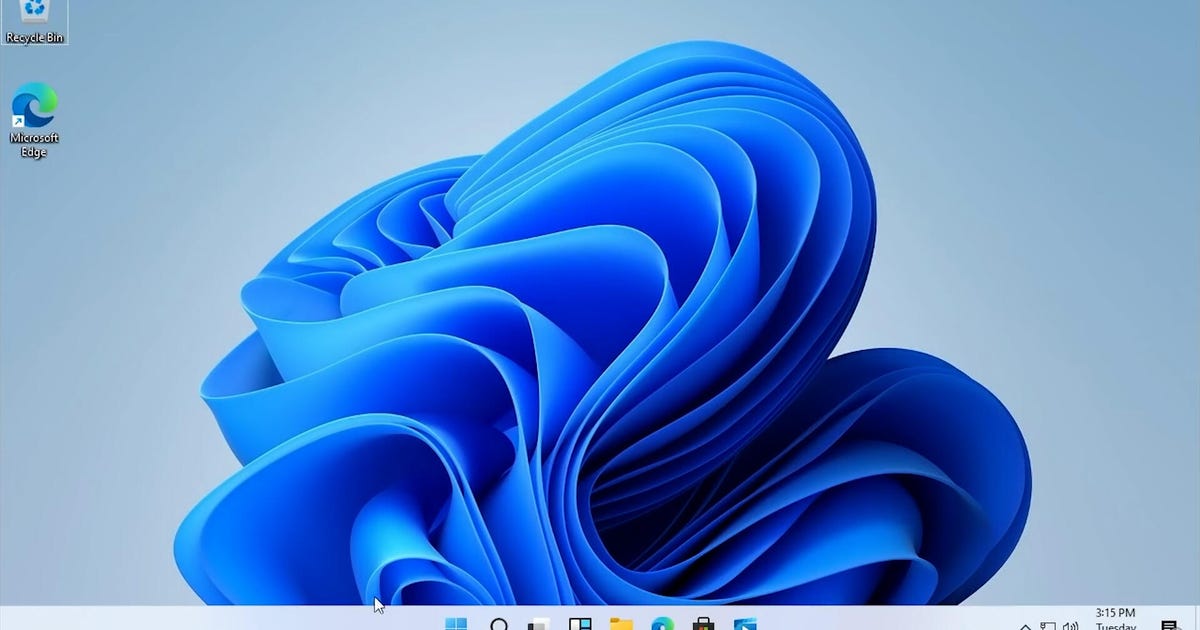
Microsoft says Android apps won't be available for Windows 11 on Oct. 5 launch
Microsoft's delaying one of the most highly anticipated features of its new Windows 11 software. The tech giant said it won't offer Android mobile phone apps on its new app store for PCs when its next iteration of Windows launches on Oct. 5 as a free upgrade for many users. Microsoft didn't give a date for when Android apps will be made available either.
Instead, the software said it plans to offer the new feature, developed in partnership with Intel and Amazon, available in a "preview" test "over the coming months."
Read more: Android apps and Windows 11: Here's what you should know
"We look forward to continuing our journey to bring Android apps to Windows 11," Microsoft said in its short statement on the matter Tuesday.
The move marks the first major setback for Microsoft's upcoming Windows 11 software, which is launching six years after Windows 10 hit store shelves. The new Android app support feature was an important selling point, alongside new visual looks, better organizational tools and improved gaming performance.
Read more: Apple's always been the anti-Microsoft. Now Windows 11 is the anti-Apple
Microsoft announced its Android app support in June, saying people will be able to find search for and install Android apps from its Microsoft Store on Windows 11. The apps would be offered through a partnership with Amazon. Before Microsoft made its plans public, there had been a couple of ways to access Android apps on Windows 10, including if you had a Samsung Galaxy phone. But Microsoft's new way promises to make it easier.
"It's just seamless and smooth," Microsoft's Chief Product Officer Panos Panay said when announcing the new feature.
§
Windows 11 started its wide rollout on Oct. 5 -- the first major upgrade in six years. Windows 11 is available as a free download for existing Windows 10 users, but it's not yet available for every compatible Windows device. And every major new feature promised isn't available right now. (Microsoft announced this in an August blog post).
We've already tested and published a full review of Windows 11 (it's familiar but fresh, with a Mac-like design). You can expect a few new multitasking features, and the Start menu is in a new place. However, it will not include one of the most anticipated updates: support for Android mobile apps in its new app store. Microsoft also didn't offer a date for when Android apps would be available either, other than saying that it would roll out in a "preview" test "over the coming months," according to the post.
There's a lot to look forward to. But even if your device hasn't been prompted to update, you can still check to see if you meet the compatibility requirements. Heads up, (you'll need to be running Windows 10 first to do so -- here's how to download Windows 10 for free if you haven't yet). And just because you have a compatible Windows device doesn't mean you'll be able to run Windows 11 starting today.
Microsoft said the launch will be "phased and measured," with new eligible devices getting the upgrade first and the rest getting offered the free upgrade sometime between October and mid-2022, depending on your hardware, age of device and other factors. You'll get a notification from Windows Update letting you know when Windows 11 is available to you, or you can check manually (here's more on how to download Windows 11 before your system asks you to).
While you wait for Microsoft's new operating system to arrive, you can check to see if your computer will be able to automatically update to Windows 11 (you'll need to be running Windows 10 first to do so -- here's how to download Windows 10 for free if you haven't yet). But even if it isn't deemed compatible, there will be a way to manually download a version that is not supported by Microsoft. And here's how to set the default search engine, if you'd rather not use Bing.
You also don't have to upgrade to Windows 11 right away if you don't want to -- Microsoft will still support Windows 10 through October 2025.
For more, check out the every big difference between Windows 10 and Windows 11 and what you'll need to do before you upgrade to Windows 11.
Source
Blog Archive
-
▼
2023
(62)
-
▼
January
(40)
- Dell XPS 17 9720 (2022) Review: Creative, With A S...
- WWE Elimination Chamber 2022: Start Times, Full Ca...
- Lenovo Yoga 9i (Gen 7, 14-inch) Review: Pretty. Im...
- What To Know About Omicron And Its Subvariants (In...
- Lorex 2K Pan-Tilt Indoor Security Camera Review: E...
- Which Smart Home Gadget Should You Buy First?
- Royal Caribbean Cruise Ships To Get SpaceX Starlin...
- Microsoft Says Android Apps Won't Be Available For...
- Windows 11 Looks A Little Different. Here's What's...
- Google's $100 Million Settlement: There's Still Ti...
- Ford F-150 Lightning Pro SSV Is Ready For Silent P...
- Google Sued By Multiple States Over How It Handles...
- Smartphone Shipments See Record Drop As Coronaviru...
- Dell XPS 13 (winter 2013) Review: Still Can't Touc...
- MultiVersus: You Can Now Play As Morty From 'Rick ...
- Chromebooks Have An Expiration Date. Here's How To...
- Scientists Read 300-year-old Sealed Letter Without...
- Move Your Toddler Into A Big Kid Bed With These 5 ...
- Thor Star Will Run Wild As WWE's Hulk Hogan In New...
- Google Sues Sonos Over Voice Control Technology
- Panic's Playdate Feels Like A Delightful, Bizarro ...
- Cadillac Will Hand-Build The Celestiq EV In Michigan
- Deadmau5 Headlines Trippy Interactive Music Journe...
- Meta Warns Of Pulling Facebook And Instagram From ...
- 'The Umbrella Academy' Season 3: Ending Explained,...
- $55,000 Honda Civic Si FE1 Is An Accessible Turnke...
- Apple WatchOS 9's New Features Include Sleep Track...
- Best Chromebook Deals: 9 Picks For Students From A...
- Refurbished IPads Are Available At Steep Discounts...
- Maya Hawke, Camila Mendes Team Up In 'Do Revenge' ...
- Why The Galaxy S22 Is So Important To Our Freedom ...
- Barry Watson Helps Reboot The Superhero Genre In T...
- Lenovo ThinkPad X12 Detachable Review: Solid Surfa...
- WhatsApp, Kik, Viber Or ReTXT: Which Third-party M...
- OnePlus 10T Gets A Little Faster By Sacrificing A Lot
- S21 Ultra Vs. S20 Ultra: Samsung Galaxy Camera Sho...
- Who Is WhatsApp Co-founder And CEO Jan Koum?
- Asus ZenBook Duo 14 UX482 Review: A Dual-screen La...
- Garmin Intros New Cycling Radar With Integrated Ca...
- Samsung's Cheaper Galaxy A Phones Get The Spotligh...
-
▼
January
(40)
